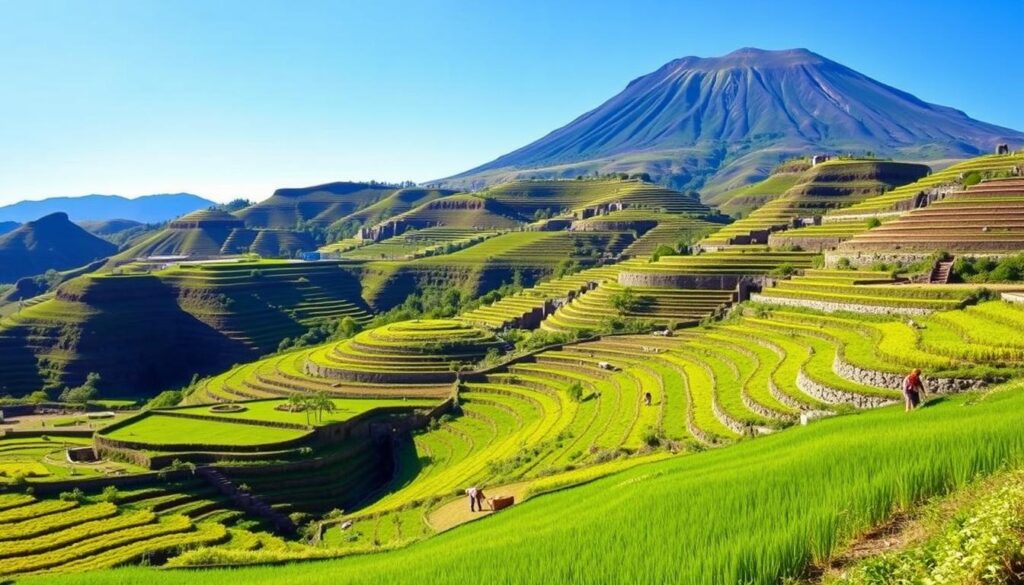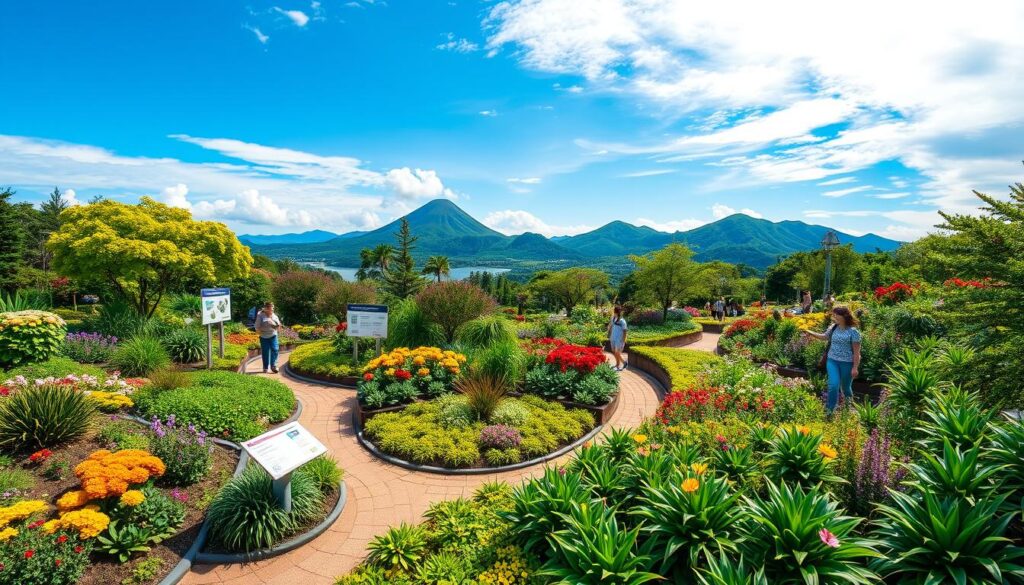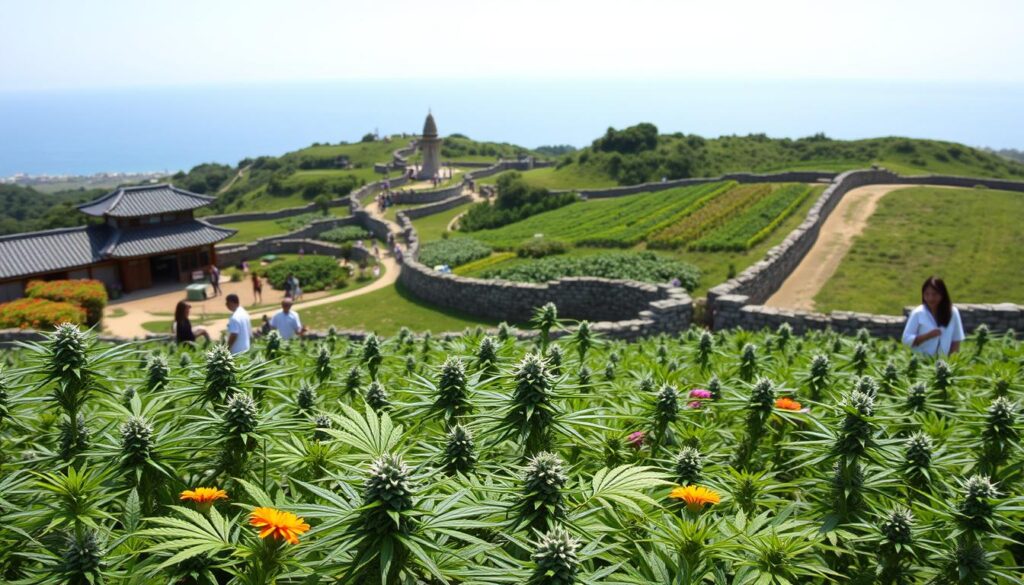Welcome to your ultimate guide to Jeju Island’s unique plants. This volcanic paradise is south of mainland South Korea. It offers a fascinating look at weed in Jeju that goes beyond what you might expect.
Jeju Island is a UNESCO Biosphere Reserve. It has a rich mix of native and introduced plants. With volcanic origins nearly 2 million years old, it’s a stunning place to learn about marijuana tourism Jeju.
As you explore this guide, you’ll see how legal cannabis in Jeju relates to the environment. The island’s special geology and climate make it perfect for plants. It’s a key area for plant research and saving nature.
Key Takeaways weed in Jeju
- Jeju Island represents a unique botanical ecosystem with diverse plant species
- The island’s volcanic landscape provides exceptional conditions for plant growth
- UNESCO Biosphere Reserve status highlights the importance of environmental preservation
- Weed culture in Jeju extends beyond traditional perceptions
- Plant diversity is crucial to understanding the island’s ecological balance
Understanding Jeju’s Native Plant Species and Biodiversity
Jeju Island is a treasure trove of plants, 90km south of Korea. It has a special ecosystem that draws in scientists and nature lovers. The island’s unique spot in the world makes it perfect for many plant species.
Being a UNESCO Biosphere Reserve, Jeju is very important for nature. It has 3,175 plant species, making it a key place for native plants.
Endemic Flora Distribution
The island’s climate is warm and oceanic. It has a lot of rain and a mild temperature. This makes it great for plants to grow.
- Warm temperate oceanic climate
- Annual precipitation ranging from 1,584.9 mm to 2,393.3 mm
- Average annual temperature of 16.2°C
Remarkable Plant Characteristics
Jeju’s plants are very interesting. For example, Hypochaeris radicata stays green all winter. This shows how strong Jeju’s plants are.
Conservation Significance
The island’s soil is volcanic ash, covering most of it. This soil is hard for plants but supports 51 endangered species. Jeju is very important for saving plants.
“Jeju’s biodiversity is not just an ecological treasure, but a living testament to nature’s remarkable adaptability.” – Environmental Research Institute
The History of Plant Cultivation weed in Jeju
Jeju’s farming history goes back centuries. It’s thanks to the island’s volcanic land. The soil and climate have shaped farming here for ages.
The story of Jeju’s farming started between A.D. 1 and 1105. Back then, farmers worked hard to farm on tough land. Today, their work still thrives.
- Tangerines dominate agricultural production (99% of farms)
- Key crops include beans, garlic, Alpine radish, and carrots
- Volcanic soil provides unique mineral-rich growing conditions
Farming in Jeju has changed over time. The land is hard to farm, with soil that’s rocky. But farmers have found ways to make it work.
| Crop Type | Cultivation Percentage | Land Coverage |
|---|---|---|
| Tangerines | 99% | Over 50% of outdoor areas |
| Beans | Significant | 15-20% of farmland |
| Garlic | Important | 10-15% of farmland |
“Jeju’s agricultural heritage is a testament to human resilience and adaptation to challenging natural environments.” – Local Agricultural Historian
Jeju’s farming success comes from family knowledge. Farmers mix old ways with new methods. They’ve turned hard volcanic land into a farming paradise.
Weed in Jeju: Native and Invasive Species
Jeju Island’s unique ecosystem faces big challenges from invasive plants. Knowing about these plants helps us understand the island’s delicate balance.
Field research shows a complex world of plant invasion on Jeju. Experts found nine invasive alien plant species changing local habitats.
Common Invasive Plants
The most notable invasive species include:
- Hypochaeris radicata (Flatweed): The most dominant invasive plant
- Rumex acetosella
- Ambrosia artemisiifolia
Impact on Local Ecosystems
These invasive plants are big threats to Jeju’s biodiversity. They spread into many places, like:
- Grasslands
- Ranches
- Roadsides
- Farmlands
- Empty lots
“The invasion of exotic species fundamentally alters the ecological balance of native habitats.”
Control Measures and Regulations
To fight these invasive plants, local authorities have strict rules. By 2021, 186 invasive alien plant taxa were found in Jeju.
| Invasive Plant Family | Number of Species | Distribution Characteristic |
|---|---|---|
| Asteraceae | 42 | Wide distribution |
| Poaceae | 38 | Adaptable to damaged ecosystems |
| Other Families | 106 | Varied distribution patterns |
When visiting weed-friendly places in Jeju, remember the island’s sensitivity. Knowing about Jeju weed laws and invasive species helps protect it. But, marijuana dispensaries in Jeju don’t relate to this issue.
Agricultural Landscapes and Plant Management
Jeju’s farms are special because they mix farming with nature. The island’s farmers work hard to grow many plants. They do this on tough volcanic land, keeping the area full of life.

- Extensive use of volcanic ash soil
- Strategic wind protection through stone fences
- Diverse crop cultivation techniques
- Adaptive management of challenging environmental conditions
The farms cover 541.9 ㎢. Most of it is citrus orchards and other crops. Tangerines are very important here, showing how farmers manage the land well.
“Jeju’s agricultural landscape is a testament to human resilience and ecological adaptation” – Local Agricultural Expert
How land is used affects plants and the environment. The types of land include:
| Land Use Type | Plant Diversity Impact | Management Intensity |
|---|---|---|
| Cropland | High species richness | Medium |
| Green Space | Moderate diversity | Low |
| Neglected Land | Variable diversity | Minimal |
| Residential Areas | Low diversity | High |
Farmers in Jeju watch out for bad plants like Hypochaeris radicata. These plants can harm the native plants. Knowing this helps farmers protect the area’s natural balance.
weed in Jeju Famous Tangerine Orchards and Vegetation
Jeju Island is a citrus paradise. It’s famous for its tangerines. The island’s climate and soil are perfect for growing delicious tangerines.
Farming on Jeju is all about being green. Farmers use new ways to grow citrus. They care a lot about the environment and use smart farming methods.
Traditional Farming Methods
Local farmers have special ways to grow tangerines. These ways have been passed down for a long time. They include:
- Careful hand-pruning of trees
- Natural soil management techniques
- Preserving traditional orchard layouts
Pest Control Practices
Jeju farmers use green ways to fight pests. They use:
- Biological control methods
- Minimal chemical interventions
- Natural predator introduction
“Our tangerines are more than a crop – they’re a legacy of Jeju’s agricultural heritage.”
Sustainable Agriculture Initiatives
Jeju farmers are really into sustainable farming. They do things like:
- Reducing chemical fertilizer usage
- Implementing water conservation techniques
- Protecting local biodiversity
Did you know? 95% of citrus sold in Korea comes from Jeju island. Jeju grows over 40 mandarin varieties. It’s a big player in citrus production and cares about the planet.
Land Use Types and Plant Distribution
Jeju Island has many different land uses. This affects where plants grow. Almost all farms grow tangerines. This makes the island’s plants very interesting.
- Croplands (primarily tangerine orchards)
- Green spaces (natural grasslands and shrublands)
- Neglected lands (abandoned or unused spaces)
- Residential areas
Scientists found out a lot about Jeju’s plants. They found that tangerine orchards have the most plant types. This is because people removing weeds helps plants grow better.
“The landscape of Jeju is a complex tapestry of vegetation, where human intervention and natural processes intertwine.” – Ecological Research Team
Invasive plants like Hypochaeris radicata are a big problem. They are found in many places, like fields and roadsides.
| Land Use Type | Plant Species Diversity | Invasive Species Presence |
|---|---|---|
| Croplands | Highest Diversity | Moderate |
| Green Spaces | Moderate Diversity | Low |
| Neglected Lands | Low Diversity | High |
| Residential Areas | Low Diversity | Moderate |
Jeju’s land use shows a balance between people and nature. Knowing this helps keep the island’s plants special.
Conservation Efforts and Biodiversity Protection
Jeju conservation is very important. It aims to keep the island’s unique nature safe. Both the government and local people must work together to protect it.
Keeping Jeju’s nature safe is a big job. It needs many steps to tackle different problems. Researchers say it’s complex to protect all the different life forms.
Government Initiatives
The local government has started many important plans:
- Creating safe areas for nature
- Stopping bad species from coming in
- Watching over the environment closely
- Supporting research to keep nature safe
Community Involvement
Local people are key in saving Jeju. They help in many ways. This teamwork helps keep the island’s special nature safe.
| Conservation Focus Area | Community Participation Rate |
|---|---|
| Invasive Species Removal | 65% |
| Native Plant Restoration | 55% |
| Ecological Monitoring | 45% |
Future Conservation Plans
Jeju will keep working to protect its nature. They will focus on living in a way that doesn’t harm the planet. They will also get ready for changes in the weather.
“Our ecosystem is our legacy – protecting it requires collective commitment and forward-thinking approaches.” – Local Conservation Expert
Your help and support are very important. They can help keep Jeju’s amazing nature safe for the future.
Plant Tourism and Educational Programs

Explore the wonder of weed in Jeju. It changes how you see this amazing island’s plants. Walking through Jeju’s green areas is like stepping into a world of natural beauty and learning.
Jeju Island is a paradise for those who love plants and nature. You’ll find many places to learn about the island’s plants:
- O’sulloc Tea Museum – Learn about tea growing and making
- Hallim Park – See many plants near Hyeopjae Beach
- Bijarim Forest – See the biggest nutmeg tree collection in the world
- Gotjawal Forest – Discover important freshwater areas
Botanical education in Jeju is more than just looking around. It teaches you about taking care of the environment. You’ll learn about saving plants and managing them well through fun activities.
“Jeju’s plant tourism offers more than scenery—it’s a living classroom of ecological discovery.” – Local Environmental Guide
For nature lovers, Jeju has special learning trips. These trips mix learning with stunning views. Whether you’re a student, researcher, or just curious, you’ll connect deeply with Jeju’s plants.
Environmental Challenges and Solutions
Jeju Island is at a key moment for saving its environment. The island’s special ecosystem is facing big challenges from climate change and changes in habitats. It’s important to understand these issues to protect the island’s diverse life.
Climate change is having a big impact on Jeju’s environment. Studies show big changes happening:
Climate Change Effects
- Southern parts of the island are most at risk
- Invasive weeds could grow up to 1439.65% by 2070
- Changes in temperature are moving native plants
Jeju’s delicate balance is under pressure from climate change.
Habitat Loss Prevention
It’s important to act quickly to stop ecological damage. Governments and local groups are working together to save vulnerable areas.
| Intervention Type | Annual Investment | Impact |
|---|---|---|
| Invasive Species Control | 4.3 Million USD | Reduce alien plant invasion |
| Habitat Restoration | 2.5 Million USD | Protect native biodiversity |
Restoration Projects
Efforts are underway to fix damaged areas. Key steps include:
- Bringing back native plants
- Creating paths for wildlife
- Using green practices for land use
“Protecting Jeju’s ecosystem requires collaborative, innovative solutions that balance conservation with sustainable development.” – Environmental Research Institute of Jeju
Your help and knowledge are key to saving Jeju’s amazing nature for the future.
Sustainable Plant Management Practices
Jeju Island is a leader in green farming. It uses new ways to care for plants and protect nature. The island’s special ecosystem, a UNESCO Biosphere Reserve since 2002, helps with these green farming methods.
- Integrated pest control methods
- Organic cultivation techniques
- Water conservation practices
- Biodiversity preservation
Jeju’s farming is all about caring for plants without harming the environment. Experts have found ways to stop bad plants from growing. They use special mowing and safe herbicides.
“Our goal is to balance agricultural productivity with ecosystem preservation,” says a local agricultural expert.
| Management Practice | Environmental Benefit |
|---|---|
| Targeted Mowing | Reduces invasive plant spread |
| Organic Pest Control | Minimizes chemical contamination |
| Water Conservation | Protects local water resources |
Jeju’s farming looks at many things, like the weather. The island’s weather, with temperatures from 16.6°C to 20.4°C and rain from 1769.5 mm to 1841.1 mm, guides its farming.
Learning about these green practices helps support Jeju’s work. It keeps nature and farming in balance.
Conclusion
Jeju’s plant world is full of life and danger. The island’s future depends on saving its plants. Since 1989, 24.9% of natural habitats have been lost.
Protecting Jeju’s plants is more than just saving green areas. It’s about understanding how plants and animals live together. The island’s farms show how to grow food in a way that’s good for the planet.
Tourism is changing Jeju’s nature. Your help is needed. By supporting research and green practices, you can help keep Jeju special.
Jeju is at a crossroads. Your love for its plants can help it stay healthy. This island is a symbol of hope for our planet’s future.

I Was looking for weed and i came across Zeus weed recommended by a friend . Zeus is super friendly, making it easy to get cannabis products. The delivery service is reliable with professional riders ensuring timely arrivals.
The quality of their products is top-notch, and their customer service is attentive and knowledgeable, offering helpful recommendations. Highly recommended for anyone seeking convenience, quality, and professionalism.
Contact him on his telegram link telegram : t.me/alphakushOG
Contact him email : alphakushog@gmail.com
Note:
He accept only btc/usdt and do not take cash payment and also he do not have telegram channel so dont contact any one on telegram channel.
Thanks bro, we ordered from him for the first time and couldn’t have been happier. They were willing to drive all the way out to my hotel as fast as possible . They were very helpful when we had a bunch of questions on the strains. We used both the telegram app and text them directly . Prices are extremely reasonable – cheaper than where we were ordering from for years. They also have the strongest cannabis we’ve seen being sold – which my wife needs for medical reasons.
Will definitely be ordering from Zeus weed again.
Excellent Customer Service!!
It’s so great to speak with nice humans that care about their customers. Every order I’ve made has been 100%.
I will absolutely continue to purchase from Zeus Weed.
Zeus Weed is what made my experience great! He was kind to me and patient and answered all my questions. I loved everything about the experience. Highly recommend!
email them.. alphakushog@gmail.com
Ordering was effortless. The delivery time was faster than expected, and the delivery guy called me to coordinate the pick up spot and was very respectful. The only problem is that i have to send bitcoin which i am not not use to it .